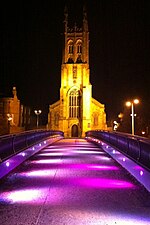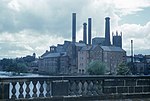Handyside Bridge
1877 establishments in EnglandBridges across the River Derwent, DerbyshireBridges completed in 1877Bridges in DerbyFormer railway bridges in the United Kingdom ... and 4 more
Grade II listed bridgesGreat Northern Railway (Great Britain)Tied arch bridges in the United KingdomUse British English from January 2018

Handyside Bridge, also known as Derwent Bridge, is a former railway bridge in Darley Abbey, Derbyshire, England which was converted to a foot bridge in 1976 following closure of the railway in 1968. Named for its builders, Andrew Handyside & Co., it is a tied-arch bridge constructed from riveted wrought iron and is situated at the entrance to Darley Park in Derby. It spans the River Derwent and was part of the Great Northern Railway Derbyshire Extension popularly known as the (Derby) Friargate Line. The next station to the south was Friargate which has another bridge built by Andrew Handyside.
Excerpt from the Wikipedia article Handyside Bridge (License: CC BY-SA 3.0, Authors, Images).Handyside Bridge
Riverside Path, Derby Little Chester
Geographical coordinates (GPS) Address External links Nearby Places Show on map
Geographical coordinates (GPS)
| Latitude | Longitude |
|---|---|
| N 52.9309 ° | E -1.4775 ° |
Address
Handyside Bridge
Riverside Path
DE1 3BA Derby, Little Chester
England, United Kingdom
Open on Google Maps









